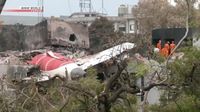The aviation world was shaken on June 12, 2025, when Air India Flight AI171, a Boeing 787-8 Dreamliner, tragically crashed moments after taking off from Ahmedabad Airport, India. Bound for London Gatwick Airport, the aircraft carried 242 people—232 passengers and 12 crew members. The crash resulted in a devastating death toll of at least 270 individuals, including 241 onboard and 29 on the ground, with a single passenger miraculously surviving.
Videos capturing the harrowing event reveal the 14-year-old Dreamliner barely climbing a few hundred feet after utilizing nearly the entire 11,500-foot runway, before descending abruptly into a densely populated residential and educational area just two kilometers from the airport. The plane struck a medical college dormitory, where many students were having lunch, causing additional casualties and injuries on the ground. Local reports confirmed four student deaths and over 40 injuries at the facility, with fears that many workers and their families were also among the victims.
Shortly before the crash, the pilot issued a terse Mayday call reporting power problems with the plane’s General Electric GEnx engines. This alarming message has become a focal point for investigators, who are now meticulously analyzing the recovered black box data. India’s Directorate General of Civil Aviation (DGCA) swiftly directed Air India to conduct additional maintenance checks on its entire fleet of 33 Boeing 787 Dreamliners to ensure safety, a process that Air India has already begun, completing one-time safety inspections on nine aircraft and progressing toward the remaining 24. These checks are expected to increase turnaround times and may cause delays on some long-haul routes.
In response to the tragedy, India’s government formed a high-level investigative committee, independent of aviation authorities, comprising government and military officials. The committee held its first session on June 16, 2025, and plans to submit a comprehensive report within three months. Boeing CEO Kelly Ortberg expressed the company’s commitment to supporting the investigation led by India’s Aircraft Accident Investigation Bureau, emphasizing adherence to international protocols.
Unfortunately, this disaster adds to a troubling pattern of safety and quality concerns that have plagued Boeing over recent years. The 787 Dreamliner, once hailed as a technological marvel, has faced a series of challenges since its inception. Its history is marred by incidents such as battery fires in 2013 that led to a global grounding of 50 aircraft for three months, and the discovery in 2020 of dangerously thin gaps between fuselage sections, halting deliveries for 20 months. Approximately 110 Dreamliners required extensive inspections and rework, with the last repairs completed only earlier this year.
Boeing’s woes extend beyond the 787. The 737 MAX program, perhaps the most infamous in recent aviation history, was grounded worldwide for 21 months following two fatal crashes in 2018 and 2019 that claimed 346 lives. Even after returning to service, the MAX has faced ongoing issues, including a 2024 incident where a door plug blew off a 737 MAX 9 operated by Alaska Airlines shortly after takeoff, leading to a temporary grounding of 171 aircraft in the U.S.
The 777X, Boeing’s ambitious re-engined and re-winged successor to the classic 777, has encountered certification delays due to flight control software bugs, uncommanded nose-down pitches, and recently discovered structural flaws that halted test flights. Certification is now hoped for by the end of 2025, six years behind schedule. Meanwhile, the KC-46A military tanker program has been plagued by production quality issues, resulting in billions of dollars in write-offs and delayed deliveries.
Adding to Boeing’s challenges are multiple whistleblower allegations exposing systemic safety compromises and retaliations within the company. Engineer Sam Salehpour raised alarms about structural flaws in the 787’s fuselage, warning of “ticking time bombs” due to improper assembly and rushed manufacturing. Other whistleblowers, including former quality manager John Barnett and mechanic Richard Cuevas, highlighted declining safety protocols and substandard maintenance practices. The tragic deaths of Barnett and another whistleblower, Joshua Dean, have cast a somber shadow over these revelations.
Financially, Boeing has been staggering under the weight of these crises. Aircraft deliveries plummeted by a third in 2024, with only 348 jetliners delivered compared to 528 the previous year, less than half of Airbus’s output. The company reported losses totaling $11.8 billion in 2024 alone, pushing cumulative losses since 2019 beyond $35 billion. Boeing recently agreed to pay over $1.1 billion to avoid prosecution related to the 2018 and 2019 crashes, a deal that has drawn sharp criticism from victims’ families.
Despite these setbacks, Boeing remains a critical supplier for Indian carriers, with Air India and Akasa Airlines placing record orders. However, the recent crash has caused Boeing’s stock to fall more than 7%, reflecting shaken investor confidence.
Air travel remains statistically one of the safest modes of transportation, but the string of recent high-profile accidents—including the Air India crash, the South Korean Jeju Air 737-800 crash in 2024 that killed 179 people, and a midair collision in Washington, D.C., earlier this year resulting in 67 deaths—has renewed calls for rigorous scrutiny and continuous improvement in aviation safety standards worldwide.
While the 787 Dreamliner crash marks the first fatal accident involving the model in its 16-year history, it underscores the critical importance of relentless vigilance in aircraft manufacturing, maintenance, and operational protocols. As regulators, manufacturers, and airlines grapple with these challenges, the aviation industry must balance innovation with uncompromising safety to restore public trust.
In the meantime, airlines renowned for their safety records continue to set benchmarks. According to airlinesrating.com, the top ten safest airlines in 2025 include Air New Zealand, Qantas, Cathay Pacific, Qatar Airways, Emirates, Virgin Australia, Etihad Airways, ANA, EVA Air, Korean Air, Alaska Airlines, and Turkish Airlines. These carriers invest heavily in crew training, fleet modernization, and adherence to stringent safety regulations, serving as models in an industry striving to learn from every tragedy.
The investigation into the Air India crash will undoubtedly be exhaustive, with global attention fixed on the findings. Whether the cause lies in manufacturing defects, pilot error, maintenance lapses, or a combination of factors, the incident serves as a stark reminder that the pursuit of safety in aviation is never complete.






